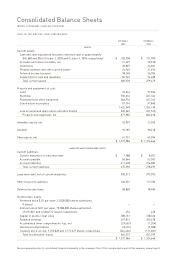Jack In The Box 2005 Annual Report Download - page 21
Download and view the complete annual report
Please find page 21 of the 2005 Jack In The Box annual report below. You can navigate through the pages in the report by either clicking on the pages listed below, or by using the keyword search tool below to find specific information within the annual report.unit economic model, while retaining operating characteristics similar to our core business. As of October 2, 2005, we owned
and operated 44 QUICK STUFF stores, and over the next five years, we expect to grow this unique co-branded convenience store
concept, in both existing and contiguous markets.
In fiscal year 2005, we opened 77 new Qdoba company-operated and franchised restaurants, representing unit growth
of more than 40% over the prior year. Qdoba’ s growth is expected to come primarily from increasing the number of franchise-
developed locations. In fiscal 2006, we plan to open 85-95 new Qdoba restaurants, including franchised units. We remain
committed to growing our fast-casual subsidiary and believe that Qdoba has significant expansion potential.
Site Selection and Design. Site selections for all new restaurants are made after an economic analysis and a review of
demographic data and other information relating to population density, traffic, competition, restaurant visibility and access,
available parking, surrounding businesses and opportunities for market penetration. Restaurants developed by franchisees are
built to our specifications on sites which have been approved by us.
We have developed multiple restaurant prototypes to help reduce costs and improve our flexibility in locating
restaurants. Management believes that the flexibility provided by the alternative configurations enables us to match the
restaurant configuration with specific economic, demographic, geographic and physical characteristics of a particular site.
Typical development costs for a traditional JACK IN THE BOX and QUICK STUFF average $1.6 million and $3.0 million,
respectively. Qdoba restaurant development costs range from $0.4 million to $0.5 million. We use lease financing and other
means to lower our cash investment in a typical JACK IN THE BOX and QUICK STUFF to approximately $0.8 million and $1.2
million, respectively.
Franchising Program
JACK IN THE BOX. Our long-term growth strategy also includes the selective expansion of our franchising operations.
As of October 2, 2005, franchisees operated 515 JACK IN THE BOX restaurants. We will continue to expand our franchising
activities, including the sale of JACK IN THE BOX company-operated restaurants to franchisees and the development of new
restaurants by franchisees. By the end of fiscal 2008, we expect to increase the percentage of franchised JACK IN THE BOX units to
approximately 35% with continued expansion beyond 35% after fiscal 2008. We offer development agreements for construction
of one or more new restaurants over a defined period of time and in a defined geographic area. Developers are required to pay a
fee, a portion of which may be credited against franchise fees due when restaurants open in the future. Developers may forfeit
such fees and lose their rights to future development if they do not maintain the required schedule of openings.
The current JACK IN THE BOX franchise agreement provides for an initial franchise fee of $50,000 per restaurant,
royalties of 5% of gross sales, marketing fees of 5% of gross sales and, in most instances, a 20-year term. Some existing
agreements provide for royalties and marketing fees at rates as low as 4%. In connection with the sale of a company-operated
restaurant, the restaurant equipment and the right to do business at that location are sold to the franchisee. The aggregate price is
equal to the negotiated fair market value of the restaurant as a going concern, which depends on various factors, including the
history of the restaurant, its location and its cash flow potential. In addition, the land and building are leased or subleased to the
franchisee at a negotiated rent, generally equal to the greater of a minimum base rent or a percentage of gross sales. The
franchisee is usually required to pay property taxes, insurance and maintenance costs.
We view our non-franchised JACK IN THE BOX units as a potential resource which, on a selected basis, can be sold to a
franchisee, generating additional current cash flows and revenues while still generating future cash flows and earnings through
franchise rents and royalties.
Qdoba Mexican Grill. We plan to continue to grow the Qdoba brand, primarily through increased franchising activities.
We offer area development agreements for the construction of five to 20 new restaurants over a defined period of time and in a
defined geographic area for a development fee, a portion of which may be credited against franchise fees due for restaurants to be
opened in the future. If the developer does not maintain the required schedule of openings, they may forfeit such fee and lose
their rights to future development. The current franchise agreement provides for an initial franchise fee of $25,000 per restaurant,
royalties of 5% of gross sales, marketing fees of up to 2% of gross sales and, in most instances, a 10-year term with a 10-year
option to extend.
Restaurant Operations
Restaurant Management. Each restaurant is operated by a company-employed manager or a franchisee who is directly
responsible for the operations of the restaurant, including product quality, service, food handling safety, cleanliness, inventory,
cash control and the conduct and appearance of employees. Our restaurant managers attend extensive management training
classes involving a combination of classroom instruction and on-the-job training in specially designated training restaurants.
Restaurant managers and supervisory personnel train other restaurant employees in accordance with detailed procedures and
guidelines using training aids available at each location. To enhance the effectiveness of our training, in 2004 we introduced a
new, interactive system of computer-based training, which replaced videotapes with a touch-screen computer terminal. The CBT
6
























